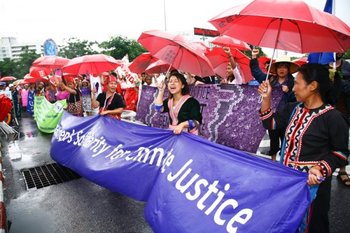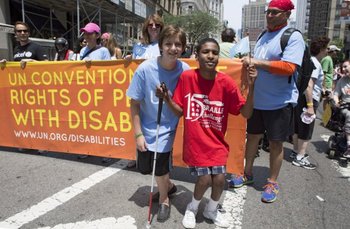The push for inclusion in humanitarian action comes from an understanding that the social and cultural landscapes in which we operate may pave one person’s road to recovery with smooth and solid stone, while filling another’s with potholes and obstacles. Yet, our understanding of gender, racial, social and cultural inequality within the sector itself is lagging.
Inclusive humanitarian action is a growing priority. In recent years, the global humanitarian sector has been making great strides in its efforts to design and implement inclusive programming. A plethora of documents outlining standards and guidance exist to enhance an inclusive response, both at a global and organisational level. Budget lines, resourcing and donor requirements are just some of the other factors that are strengthening the push for a more inclusive response.
This push to include more and more of the world’s most vulnerable into the humanitarian response system, has come from a place of understanding that not everyone has an equal footing in this world. An understanding that the social and cultural landscapes in which we operate may pave one person’s road to recovery with smooth and solid stone, while filling another’s with potholes and obstacles.

Photo credit: Mike Mozart.
This understanding has been key in beginning to re-evaluate and revolutionise humanitarian response for women and girls, sexual and gender minorities, marginalised ethnic populations and persons with a disability. Yet, our understanding of gender, racial, social and cultural inequality within the sector itself is lagging.
The irony
The irony is that we have yet to turn that depth of understanding on ourselves, to our headquarters and operational contexts. The gender, social and cultural inequality we aim to address in our programmes is less examined in humanitarian organisations, and as recent research demonstrates, in our own leadership teams.
The road to humanitarian leadership is straight and wide for some, but remains narrow and bumpy, and sometimes non-existent, for others. Unsurprisingly, the latter are the same group that require special consideration in our programming. The latest report from Humanitarian Advisory Group’s Diverse Leadership stream suggests that only 42% of humanitarians surveyed think that their immediate leadership team is inclusive, and that the composition of those teams is lacking in diversity. The statistics are stark:
- 4% of humanitarian leadership roles are filled by persons with a disability.
- 69% of the most senior leadership roles in extreme and high risk contexts are filled by men.
- 60% of the most senior leadership roles are filled by international staff.
- 75% of staff have a master’s degree or above.
Through our improved programme design practices, the sector has demonstrated that it is capable of the kind of change needed to address these disheartening statistics. Could we use the same understanding we have utilised to reform our programming, to begin to reform our internal power structures?
There are indeed linkages between diverse and inclusive leadership teams and improved leadership practices. Research suggests that diverse and inclusive teams are more likely perform well against a whole range of important performance criteria. When staff perceive their leadership teams to be more diverse and more inclusive, they are also significantly more likely to find their leaders to:
- make decisions mostly or very well
- manage risk mostly or very well
- reflect the diversity, and listen and act upon the views, of communities mostly or very well
- promote innovation mostly or very well
- listen and act upon the views of colleagues.
Does it get much better than that? These criteria are goals that every organisation should be striving towards, to have a happier, healthier cultural environment, as well as to better meet operational goals. Building on understandings from the corporate sector, where it is now widely agreed that diversity and inclusion lead to better business, the humanitarian sector may be ready to harness the full potential of its compassionate, interesting and diverse workforce through empowering those whose voices differ from the norm.
The greater irony
The sector as a whole has produced a wide suite of tools, approaches and donor incentives in its attempt to reach its diversity and inclusion goals. We strive, but continue to struggle, to ensure that those who are marginalised in communities are included in programming, and whilst improvements have been made, our efforts have not yet led to comprehensive diverse and inclusive programming practices. This is not a surprise to many.

Photo credit: Mongkhonsawat Luengvorapant/Oxfam.
The teams who are planning, implementing and leading the drive towards the implementation of diverse and inclusive humanitarian programming are themselves struggling to achieve diversity. How can a team without diversity and inclusion truly implement a new approach to diversity and inclusion? How can an organisation whose leadership walks and talks much the same as it did 20 years ago be the most well-equipped to implement such vast change? Perhaps we will never reach our goals for inclusive humanitarian operations while we are unable to apply the same logic and approaches inwards, to our own organisations and sector. After all, diverse and inclusive leadership teams do seem to have the added advantage of being able to deliver on better accountability to affected populations whilst also making their staff feel heard and appreciated.
Imagine a future where those leading our sector have the tools to create an inclusive environment that can fully utilise the diverse and innovative ideas of all humanitarian staff - where those ideas lead to improved outcomes for our affected populations, especially those most vulnerable.
A call for action
The mounting evidence is a call for action.
A call to individuals, teams, organisations and the sector as a whole, to redefine what diversity and inclusion means for us internally, and how that can have an impact on what we are doing externally.
A call to support research and initiatives that are adding to the evidence, to the best practice and to the change we all need to see. To support action that is moving the conversation from potentials and possibilities to actionable realities and facts.
A call for the sector to raise awareness, reflect on how we compose teams, and to advocate for increased diversity and inclusion both within our sector, and among those who lead the sector.
Can your organisation answer this call, by starting to integrate diversity and inclusion to improve outcomes?
We believe that progress in humanitarian action stems from the honest analysis and debate of evidence. There is a challenge to progress in this sentiment, in that most organisations lack concrete evidence and data regarding their current diversity, the inclusiveness of their culture and the relationships between these things and the ways their leadership teams operate.

If humanitarian organisations begin to investigate their own diversity and inclusion, and boldly begin to create true change within their internal operations based on the evidence they find, then we may have the power to give momentum to this critical cultural shift.
If your organisation is looking for a more detailed understanding of the diversity of their existing leadership teams, and what more diverse and inclusive practices might mean for their most pressing organisational goals, they may be interested in the next phase of our research. We will be working with partner organisations to further uncover the relationship between diversity and inclusion and effective humanitarian performance.
Get in touch:
If this sounds like something your organisation or your leadership team may benefit from, please reach out to the research team:
Pip Henty at phenty@hag.org.au
Kate Sutton at ksutton@hag.org.au
This blog is informed by the latest report from HAG’s Diverse Leadership research stream. Read the report: Data on Diversity: Humanitarian leadership under the spotlight.